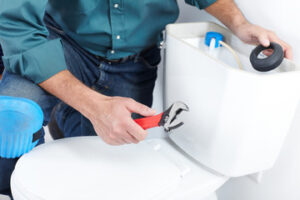Before attempting to replace the toilet’s plumbing, you should first determine the source of the leak. The most common cause of leaking toilets is a faulty flapper or floater. If you can replace the flapper yourself, you should do so. Both parts are available for less than $10 at home improvement stores. If you need professional help, you can hire Plumbing to do the job. Before beginning, it is important to read the instructions carefully and follow them closely.

If you suspect a blocked toilet, you should first check the main sewer line. A clogged toilet will likely indicate a more serious problem with your drainage system. A plumber will be able to clear a blockage quickly and efficiently. In most cases, it is not necessary to call a plumber, but a quick repair job can help avoid more expensive repairs. If you suspect that your sewer line is clogged, you should call a plumber to come out and inspect the problem.
Toilet plumbing problems can also result in a huge water bill. While the most obvious solution is to replace the toilet, a simple leak could cost you thousands of dollars in water damage. If your sewer line is clogged, a professional plumber can determine the source of the problem and fix it for a reasonable price. In some cases, a drain cleaner can actually be more harmful than the problem. To avoid further costly repairs, it is best to contact a plumber as soon as possible.
Toilet plumbing problems are a major hassle. They can increase your water bill and ruin your home’s interior. Even a minor leak could cost you thousands of dollars in damages. Similarly, frequent blockages can mean that your sewer line is clogged, causing hazardous sewage to back up into your home. Fortunately, there are solutions to prevent a disaster from happening and restore normal toilet plumbing. But before calling a plumber, be sure to consult with a professional to see what the problem is.
If your toilet plumbing is clogged, the problem could be with the main drain pipe. If this is the case, a plumber will be able to quickly fix the problem. If you don’t know who to call, you may need to hire a plumber. Thankfully, plumbing companies are trained to fix all types of toilets, so don’t delay in getting a plumber to check the clogged pipe and the septic tank.
Toilet plumbing can be difficult to repair and can be expensive. The constant use of the toilet can cause massive water bills. Even small leaks can cause thousands of dollars of damage in a short amount of time. If a drain has been clogged for a few weeks, it’s most likely that the entire sewer line is clogged. A plumber is able to repair this problem without damaging the mainline. If you have a sewer line problem, call a plumber right away.
Having a toilet plumbing problem is not only embarrassing but can also lead to a high water bill. Even a small leak can waste thousands of gallons of water each year. If the problem is with the sewer line, you need a plumber to fix the problem. A plumber will be able to determine the exact source of the problem and provide a long-lasting solution. If a plumber isn’t available, a reputable plumbing service can help you out.
In addition to the inconvenience, toilet problems can cause major expenses. If you’re using your toilet often, you may have a problem with your sewer line. A blockage in your sewer line can cause a lot of water damage. A clogged toilet can cause a large amount of money. If you’re having trouble with your toilet, call a professional right away to fix it. A plumber will be able to diagnose and fix the problem.
The first step in repairing your toilet’s plumbing is to turn off the water supply. This valve is usually located at the base of your toilet. When this valve is closed, water will no longer flow into the toilet’s tank. If the problem persists, you should call a professional to fix the problem. If the problem is with the sewer line, it will cause a major flood and cost you a lot of money. You should also consider contacting a company specializing in emergency drain clearing to prevent an emergency situation.